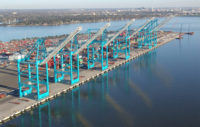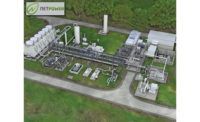Energy
Siemens Installs First Turbine for Natural-Gas Power Plant in Egypt
Part of ambitious plan to double country's electrical generating capacity

The first turbine for the Beni Suef power plant was installed in May. Three combined-cycle plants under construction will add a total of 14.4 GW to Egypt's electrical generating capacity.
Photo Courtesy Siemens AG
Siemens AG has installed the first of two 400-MW turbines at the Beni Suef combined-cycle power plant in Egypt, a major milestone in the construction of three Egyptian power plants that will have a total capacity of 14.4 GW. Once completed, the three natural-gas, combined-cycle plants will be some of the largest in the world.
Munich-based Siemens has partnered with Egyptian firms El Sewedy Electric T&D and Orascom Construction for the construction of three plants, located at Beni Suef, Burullus, and a yet-to-be-built new administrative capitol near Cairo. Installation of the SGT5-8000H gas turbine began on May 19 at the Beni Suef facility. The power plant is set for completion in 2017, with the other two to be finished by 2018.
The Siemens-led consortium in June 2015 signed contracts worth $8.9 billion for the three, high-efficiency natural-gas-fired power plants, as well as for several wind-power installations for a total of 16 GW of generating capacity. When completed, these projects will increase Egypt’s overall electricity capacity by 50%. The $6.84-billion order for the three combined-cycle plants is the largest such order in Siemens’ history.
At Beni Suef, eight of the SGT5-8000H gas turbines—which have a gross power output of 400 MW and an efficiency of 60.75% in combined-cycle operation, according to Siemens—will be installed in four stages. Each stage will include installation of two H-class gas turbines, two heat-recovery steam generators and a steam turbine.
Siemens said the Beni Suef natural-gas power plant, which is set for completion within 19 months, will start operation in a simple-cycle mode before being expanded into a combined-cycle mode through the addition of heat exchangers and steam turbines. When fully on line, it will generate 4.8 GW of electricity, enough to supply 15 million people.
Siemens and its partners signed a separate contract with the Egyptian government in November 2015 for the construction of six substations at El Minia, El Beheria, Qalubia, Assiut and Kafr El Zayat. The 500 to 200-kV substations initially will transmit the power generated from the new Beni Suef and Burullus power plants.
“These substations will integrate the new, highly-efficient power plants from Siemens into the grid and enable Egypt to accommodate increasing demand from domestic and industrial customers,” said Wolfgang Braun, senior executive vice president, Siemens Middle East, at the time of the contract signing.
Siemens will perform the designing, engineering, supplying, installation and commissioning of the new substations, which include a gas-insulated switchgear, transformers, and control and protection equipment. El Sewedy Electric T&D will perform civil and mechanical work.
Ahead of the 2018 completion of the new power plants, Siemens also is helping Egypt meet its 2016 summer power demands through “a fast-track plan to provide 800 megawatts [of] power-generation capacity to deal with the peak demand,” according to Siemens AG president and CEO Joe Kaeser in an interview in October 2015.
He said Siemens “will help refurbish the steam turbines at the Attaka thermal power plant and an upgrade of the Kureimat combined-cycle power plant.”
“We have proposed the installation of distributed generation units to deliver additional power-generation capacity on short notice close to locations where demand is highest,” he said.
Kaeser said the short-term strategy by Siemens will help Egypt to minimize the need for “huge new investments, since it is focused on raising the capacity of existing power-generation units without investing large amounts of money in building new units to meet temporary needs.”
A consortium of 17 international banks has raised $3.9 billion for the three power projects, with the financing having been structured and arranged by Deutsche Bank, KfW IPEX-Bank and HSBC.
In June 2015, Siemens signed a contract with Egypt for the supply of 600 wind turbines for at least 12 wind-energy projects in the Gulf of Suez and in the West Nile region. The company also received approval for the construction of a rotor-blade manufacturing plant in the Ain Soukhna area, located on the banks of the Gulf of Suez, with the potential to create 1,000 jobs. Egypt hopes to generate 7.2 GW from wind farms in the Gulf of Suez and the West Nile by 2020.
Egypt, which has a current generation capacity of 31.45 GW, has set a goal of generating an additional 30 GW of electricity by 2020. Currently, 70% of the country’s electricity is derived from natural gas, while the rest is generated by petroleum or renewable-energy sources.



